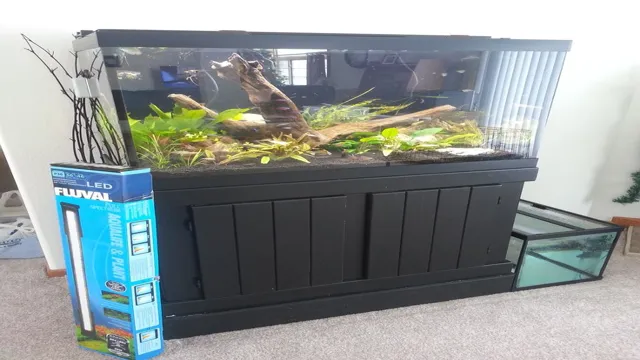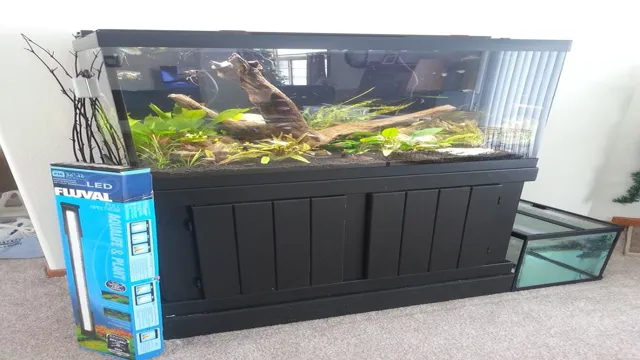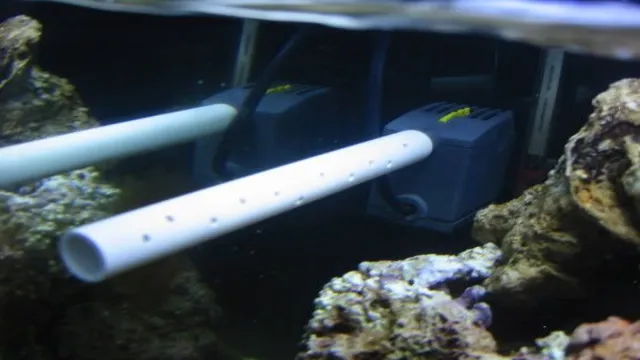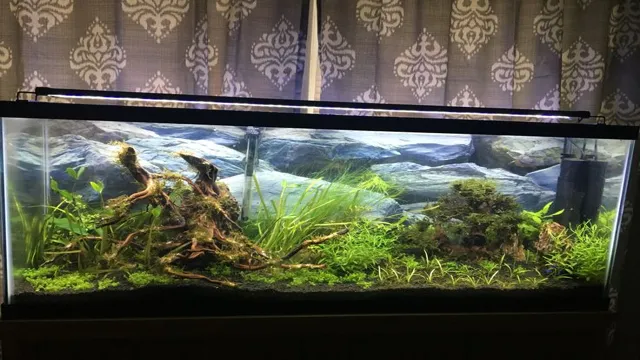So, you’re an aquarium enthusiast looking to build a new 65-gallon aquarium stand? Well, you’ve come to the right place because we’ve got you covered with all the steps you need to get started! Building an aquarium stand may seem like a daunting task, but with some basic woodworking skills, it’s actually quite manageable. Not only will you be able to create a beautiful stand that perfectly fits your aquarium, but you’ll also have the satisfaction of knowing that you accomplished it yourself. Before you begin, there are a few things you should consider, such as what type of wood you want to use and what tools you’ll need.
We’ll walk you through all the steps necessary to build a sturdy and reliable stand that will last for years. So, grab your tools and let’s get started! We can’t wait to see the finished product and the happy fish that will call your new aquarium home.
Materials Needed
If you’re interested in building a 65 gallon aquarium stand, there are a few materials you’ll need to get started. First, you’ll need plenty of sturdy lumber – ideally, at least 2x4s – to form the frame of your stand. You’ll also need screws, nails, and brackets to hold everything together securely.
Don’t forget about tools! A circular saw, drill, and level are essential for cutting and assembling your lumber properly. Additionally, you’ll want to invest in some stain or paint to give your stand a finished, polished look. Finally, consider adding some decorative touches like molding or trim to make your stand really stand out.
With these materials and a little bit of effort, you’ll have a beautiful and functional aquarium stand in no time!
Wood (specific types and lengths)
When it comes to building things out of wood, it’s important to choose the right type and length for the job at hand. Some types of wood are better suited for outdoor use, while others are better for indoor projects. For example, cedar and redwood are popular choices for outdoor projects because they are naturally insect and rot-resistant.
If you’re building something that will be painted or stained, you might want to consider using a smooth, knot-free wood like pine or poplar. Additionally, the length of the wood you choose will depend on the size of your project. Shorter boards are great for small projects like birdhouses or picture frames, while longer boards are better for larger projects like decks or fences.
No matter what type or length of wood you choose, make sure to measure and cut carefully to create a finished project that looks professional and lasts for years to come.

Screws, nails, and adhesive
When it comes to home building, screws, nails, and adhesive are three of the most commonly used materials. They each play a critical role in the structure, durability, and aesthetics of the final product. Screws are used to securely fasten two or more pieces of material together and come in a variety of sizes and materials.
Nails are used for lighter tasks and are typically quicker and easier to install but may not be as strong as screws. Adhesives, such as glue or silicone, are used for joining materials together in permanent bonds. When selecting the appropriate screw, nail, or adhesive, it’s essential to consider the environment in which it will be used, the weight load it will support, and the desired appearance of the final work.
By selecting the correct materials, homeowners can ensure their projects will hold up to the elements and last for years to come. So, let’s build with confidence, using screws, nails, and adhesives that are suited for the specific job at hand.
Saw, drill, and measuring tape
When it comes to woodworking, having the right tools can make all the difference. If you’re looking to get started in this craft, one of the first things you’ll need to do is gather the necessary materials. Here are three essential tools that every woodworker should have: a saw, a drill, and a measuring tape.
A good saw is necessary for cutting wood into the desired shapes and sizes, whether it’s a handheld saw or a power saw. A drill is essential for making holes in the wood, whether it’s for attaching hardware or simply creating decorative elements. And a measuring tape helps ensure that everything is precisely aligned and cut to the right length.
With these tools at your disposal, you’ll be well on your way to creating beautiful, functional pieces of furniture or decorative items for your home.
Preparing the Wood
To build a sturdy and durable 65 gallon aquarium stand, it’s crucial to start with quality materials and prepare them appropriately. Begin by selecting pressure-treated pine lumber or hardwood as it’s strong enough to support tank weight. Measure and cut the wood with a circular saw, taking extra care to ensure that all pieces are of the correct length and height. (See Also: How to Get to the Baltimore Aquarium from Washington DC: Easy Guide)
Then, sand down the edges and smooth out any rough corners using sandpaper or a wood rasp to avoid splinters. After preparing each piece, use wood glue and clamps to join the sides and front, then attach the back panel using screws and a drill. Be sure to check for squareness by utilizing a level and make adjustments as necessary.
To finish, sand down the entire assembled frame and apply a coat of paint or varnish to protect it from moisture. By taking these necessary steps, you can ensure that your DIY aquarium stand will last for years to come.
Cutting specific pieces to length
When it comes to cutting specific pieces of wood to length, proper preparation is crucial. Before starting, ensure that the wood is dry and free from any cracks or knots that may alter the desired measurements. It is also essential to have the right tools at hand, including a reliable saw, measuring tape, and a sturdy work surface.
Before cutting, measure the length of the wood using the measuring tape, ensuring that the dimensions are exact. Make sure to mark the wood carefully to avoid any mistakes when cutting. When sawing, ensure that the blade is sharp and in good condition to prevent splintering or rough edges.
Taking the necessary precautions and preparing the wood correctly will ensure precise and accurate cuts every time, which is crucial when working on various woodworking projects.
Sanding and smoothing rough edges
When it comes to working with wood, sanding and smoothing rough edges is a crucial step in preparing the material. Not only does it help to create a clean and polished finish, but it also makes the wood easier and safer to work with. Before starting the sanding process, it’s important to have the right tools on hand, including sandpaper and a sanding block or machine.
Depending on the type of wood and its condition, a variety of grit levels may be needed to achieve the desired result. Starting with a coarser grit and working your way to a finer grit will help to gradually remove any roughness and ensure a smooth surface. Take your time and be careful not to over-sand or damage the wood.
Remember to always wear protective gear and work in a well-ventilated area. By properly preparing the wood, you’ll be able to create a beautiful finished product that will last for years to come.
Construction
Building your own aquarium stand can seem intimidating, but it’s actually not as difficult as you might think. To build a 65 gallon aquarium stand, you’ll need to start by gathering your materials and tools, including lumber, screws, a saw, and a drill. Once you have everything you need, you’ll want to measure and cut your pieces according to your design.
Be sure to double-check your measurements and make any necessary adjustments before moving on to assembly. When putting your stand together, it’s important to use screws rather than nails for added strength and stability. It’s also a good idea to paint or stain your stand to protect it from moisture and give it a finished look.
By following these steps and taking your time, you can build a sturdy and functional aquarium stand that will showcase your 65-gallon tank beautifully.
Assembling the frame
Assembling the frame is a critical part of construction when building anything whether it’s a house, a commercial building, or a backyard shed. The frame is the skeletal structure of the building, and it’s essential to make sure that it’s strong enough to support the weight of the walls, roof, and everything else above it. When starting to construct a frame, the first step is to lay out the perimeter of the building using stakes, string, and a measuring tape.
Then, the next step is to insert a base plate, which acts as the foundation of the frame, and attach it to the foundation. After that, the vertical studs can be placed and fastened to the baseplate. Finally, the top plates are added to connect the studs and create a continuous frame. (See Also: How Strong is Aquarium Glass? Exploring the Durability of Fish Tank Glass)
By ensuring that each stage of construction is done carefully, your frame will be solid and stable for the rest of the building process.
Attaching the base and top
When it comes to constructing the base and top of any project, the process can seem overwhelming. However, with the proper tools, it can be a smooth and simple process. One crucial step is attaching the base and top.
Start by securing the base with the appropriate screws and adding glue to ensure stability. Take time to make sure it is level and secure before moving on to the top. Once the base is secured, attach the top using screws or other suitable fasteners.
Make sure it is level and centered before tightening the screws. By following these steps, you can ensure a sturdy and reliable structure suitable for your project. Remember to use the appropriate tools and take your time to ensure each step is completed correctly.
With patience and perseverance, you can create a solid base and top that will be the foundation for your project.
Adding support beams
When it comes to construction, ensuring proper support is essential for the stability and safety of any building. This is where support beams come in. Installing support beams provides an extra layer of reinforcement to the building’s structure, allowing it to withstand heavy loads and prevent it from collapsing.
The support beams can be made of various materials, such as wood or steel, depending on the needs and requirements of the project. These beams are usually placed horizontally across the structure, distributing the weight of the building evenly and reducing stress on any one particular area. By adding support beams, you can ensure that your building is not only sturdy but also long-lasting, providing you with peace of mind knowing that your construction project is built to last.
Finishing Touches
Now that your 65-gallon aquarium stand is assembled, it’s time to add some finishing touches to make it look polished and professional. One easy way to do this is by painting or staining your stand to match your home decor. Not only will this give your stand a sleek look, but it will also protect it from scratches and moisture.
Another option is adding trim or molding to the edges of your stand. This will not only add a decorative touch, but it can also help hide any imperfections or gaps. Lastly, consider adding adjustable feet to your stand to ensure that it’s level and stable.
This will prevent any unsteady wobbling and keep your aquarium safe and secure. By taking these simple steps, you can customize and perfect your aquarium stand for a beautiful and functional addition to your home aquarium setup.
Painting or staining the wood
As you near the final stages of your woodworking project, it’s time to decide whether you want to paint or stain the wood for a beautiful finish. Choosing between the two comes down to personal preference and the type of look you want to achieve. If you want to give your wood a uniform look and color, then painting is for you.
With the array of colors available, you can choose the perfect shade to go with your decor. However, if you want to retain the wood’s natural beauty while adding a protective layer, then staining might be your best bet. Staining highlights the wood’s grain and gives it a rich, warm tone.
Not to mention, stained wood is less likely to peel or crack like painted wood tends to do over time. When it comes to staining, there are various colors and finishes to choose from as well. Take your time in deciding which direction to go, and remember that either choice will add the finishing touches to your woodworking project.
Adding a waterproof sealant
Adding a waterproof sealant is one of the most crucial finishing touches when it comes to protecting your project from water damage. Whether it’s an outdoor deck or a bathroom remodel, a waterproof sealant will prevent water from seeping into your project and causing damage over time. It’s important to choose the right sealant for your project and to follow the manufacturer’s instructions for application. (See Also: How to Make Fake Plants Aquarium Ready: Easy Steps and Tips)
Not only will a waterproof sealant protect your project from water damage, but it can also help to extend its lifespan. Don’t skimp on this crucial step in the finishing process – it’s well worth the investment for the long-term protection and durability of your project.
Conclusion
In conclusion, building a 65 gallon aquarium stand is a rewarding and thrilling experience for any DIY enthusiast. Much like the process of setting up an aquarium, building the stand requires patience, attention to detail, and a willingness to get your hands dirty. But with the right tools, materials, and the help of a trusted guide, you’ll be well on your way to creating a sturdy and stylish addition to your home.
So go ahead, dive in headfirst, and start building your dream aquarium stand today!”
FAQs
What are the materials required to build a 65 gallon aquarium stand?
The materials required to build a 65 gallon aquarium stand include wood, screws, nails, hammer, drill, saw, measuring tape, and sandpaper.
Can I use pallet wood to build a 65 gallon aquarium stand?
Although pallet wood may seem like a cost-effective option, it is not recommended for building a 65 gallon aquarium stand as it may not be strong enough to support the weight of the aquarium.
How long will it take to build a 65 gallon aquarium stand?
The time taken to build a 65 gallon aquarium stand may vary depending on your skills and experience with woodworking. On average, it can take about 1-2 days to complete the project.
Is it necessary to paint or stain the aquarium stand?
While it is not necessary to paint or stain the aquarium stand, it can help protect the wood from moisture and give it a more polished look.
How much weight can a 65 gallon aquarium stand hold?
Generally, a 65 gallon aquarium stand should be able to hold at least 500-600 pounds of weight.
Can I modify the design of the aquarium stand to fit my needs?
Yes, you can modify the design of the aquarium stand to fit your specific needs or preferences, but be sure to keep in mind the weight-bearing capacity and stability of the stand.
Do I need any special tools or skills to build a 65 gallon aquarium stand?
While some woodworking experience and tools are required to build a 65 gallon aquarium stand, it is not an advanced project and can be done with basic carpentry skills and tools.







